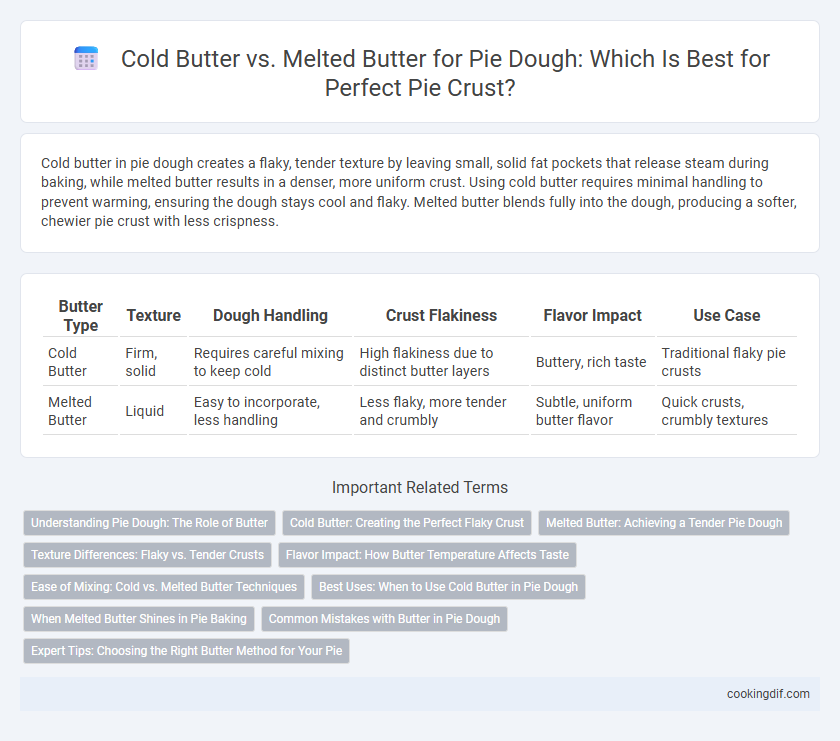Cold butter in pie dough creates a flaky, tender texture by leaving small, solid fat pockets that release steam during baking, while melted butter results in a denser, more uniform crust. Using cold butter requires minimal handling to prevent warming, ensuring the dough stays cool and flaky. Melted butter blends fully into the dough, producing a softer, chewier pie crust with less crispness.
Table of Comparison
| Butter Type | Texture | Dough Handling | Crust Flakiness | Flavor Impact | Use Case |
|---|---|---|---|---|---|
| Cold Butter | Firm, solid | Requires careful mixing to keep cold | High flakiness due to distinct butter layers | Buttery, rich taste | Traditional flaky pie crusts |
| Melted Butter | Liquid | Easy to incorporate, less handling | Less flaky, more tender and crumbly | Subtle, uniform butter flavor | Quick crusts, crumbly textures |
Understanding Pie Dough: The Role of Butter
Cold butter in pie dough creates a flaky texture by releasing steam during baking, forming distinct layers, while melted butter results in a denser, less tender crust due to the absence of these air pockets. The temperature and state of butter directly impact gluten development and dough handling, with cold butter limiting gluten formation for a crumbly bite. Choosing cold butter preserves the pie's traditional flakiness, integral to classic pie crusts.
Cold Butter: Creating the Perfect Flaky Crust
Cold butter is essential for creating a perfectly flaky pie crust because it stays solid while being incorporated into the flour, forming small, distinct pockets that melt during baking to create layers. Using butter chilled at around 40degF (4degC) helps maintain these layers, preventing the dough from becoming tough or greasy. Keeping the butter cold also slows gluten development, resulting in a tender, crisp crust ideal for both sweet and savory pies.
Melted Butter: Achieving a Tender Pie Dough
Melted butter in pie dough creates a tender and flaky texture by coating flour proteins more thoroughly, inhibiting excessive gluten formation. This method results in a softer dough that bakes into a delicate, melt-in-your-mouth crust. Using melted butter also simplifies mixing, ensuring even fat distribution for consistent pie crust quality.
Texture Differences: Flaky vs. Tender Crusts
Cold butter in pie dough creates steam during baking, resulting in flaky, layered crusts prized for their crisp texture. Melted butter blends fully with flour, producing a tender, soft crust with less distinct layers and a more cake-like crumb. Choosing cold butter enhances flakiness, while melted butter favors a delicate, melt-in-the-mouth finish.
Flavor Impact: How Butter Temperature Affects Taste
Cold butter in pie dough creates a flaky texture by forming distinct layers, enhancing the butter's rich, creamy flavor as it melts during baking. Melted butter blends fully with flour, producing a denser crust with a less pronounced buttery taste and a softer texture. Temperature of butter directly influences the flavor intensity and mouthfeel, making cold butter preferable for a flavorful, flaky pie crust.
Ease of Mixing: Cold vs. Melted Butter Techniques
Cold butter in pie dough creates a flaky texture by remaining in small, solid pieces that trap air during baking, making the mixing process more challenging but effective for flakiness. Melted butter incorporates easily and evenly, streamlining mixing but resulting in a denser, less flaky crust. Choosing between cold and melted butter depends on the desired crust texture and the ease of dough preparation.
Best Uses: When to Use Cold Butter in Pie Dough
Cold butter is essential for creating flaky pie crusts because it stays solid during dough mixing, forming small pockets of fat that release steam while baking. This process results in a tender, airy texture ideal for classic fruit pies and savory quiches. Using cold butter is best when the goal is a crisp, crumbly crust with distinct layers.
When Melted Butter Shines in Pie Baking
Melted butter creates a tender, flaky pie crust by coating flour proteins more evenly, which reduces gluten formation and results in a softer texture. It is particularly effective in recipes requiring a crumbly, shortbread-like base, such as fruit tarts or cookie pies. Using melted butter also simplifies mixing, allowing for quicker dough preparation without compromising flavor.
Common Mistakes with Butter in Pie Dough
Using melted butter instead of cold butter in pie dough often leads to a greasy texture and tough crust because melted butter fails to create the necessary flaky layers. Common mistakes include overworking the dough when using warm butter, causing gluten development that results in a dense pie crust. Cold butter, cut into small pieces and worked quickly, ensures a tender, flaky crust by maintaining solid fat pockets that melt during baking.
Expert Tips: Choosing the Right Butter Method for Your Pie
Cold butter is ideal for flaky pie crusts because it creates small pockets of steam during baking, resulting in a tender, layered texture. Melted butter yields a denser, more uniform dough that is easier to roll but lacks the desired flakiness sought in classic pie crusts. Experts recommend using chilled, cubed butter and minimal handling to achieve the perfect balance of crispiness and tenderness in pie dough.
Cold butter vs melted butter for pie dough Infographic

 cookingdif.com
cookingdif.com